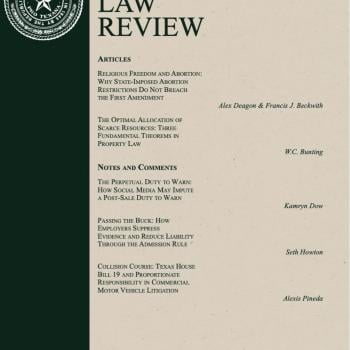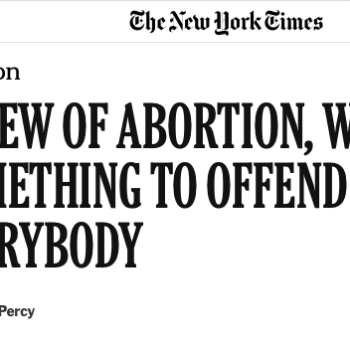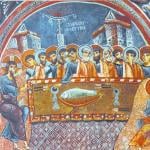Over at National Review’s “The Corner,” Robert VerBruggen writes:
What’s not clear to me, however, is why “distinct DNA” should be the criterion by which we judge personhood for moral and legal purposes. As Reason’s Ronald
Bailey has pointed out, 60 to 80 percent of human embryos — post-conception, with distinct DNA — are naturally destroyed by the woman’s body. Are we to see this as a large-scale massacre of human beings, develop drugs to prevent it from happening, and require all women who have unprotected sex to take them? Certainly, we would be willing to take measures like this if post-birth infants were dying in comparable numbers.
First, VerBruggen is not correct in saying that the prolife position depends exclusively on the “distinct DNA” of an embryo in order to affirm its personhood. Rather, the prolifer believes that the embryo is a person because of the sort of thing that it is, a rational animal, an individual human substance whose parts are intrinsically ordered to work in concert for the good of the whole. It is an individual being who owns properties and parts and is not a property or part of something else, like its foot or its weight. The fact that the embryo has its own DNA distinct from either parent’s DNA is not what makes it a person. After all, my hand’s DNA is distinct from my wife’s DNA, but that does not make my hand a person. It is, to be sure, a part of a person, but it is not an individual human substance. Rather, it is a part of a rational animal whose existence began at the moment of its conception over 51 years ago. (For more on the “substance view of persons,” see my chapter “The Human Being, a Person of Substance: A Response to Dean Stretton,” in Persons, Moral Worth, and Embryos: A Critical Analysis of Pro-Choice Arguments, ed. Stephen Napier [Dordrecht: Springer, 2011], 67-83).
I understand that VerBruggen was quoting fellow NRO blogger, David French, who writes: “Indeed, scientists are virtually unanimous in declaring that the result of conception is a human child with a distinct DNA different from his or her parents. This unanimity is the essence of `overwhelming consensus.'” Notice, however, that David is not saying that “distinct DNA” is a sufficient condition for personhood. Rather, he is arguing that a human child already exists and that it happens to have its own “distinct DNA” that differs from its parents’ DNA. It would be like saying that “Fred is an individual human child, since he has his own hands and feet that are not the hands and feet of his parents.” But having hands or feet are not sufficient for human personhood, since chimps have hands and feet and some human beings, like the thalidomide babies, lack them.
Second, VenBruggen’s argument from “embryo wastage” is flawed as well. As I write in my book, Defending Life: A Moral and Legal Case Against Abortion Choice (Cambridge University Press, 2007), 75-77 (notes omitted):
Objection 3: Because so many pregnancies result in miscarriages or spontaneous abortions, it is difficult to believe the unborn are complete human beings during their entire gestation.
Not every conception results in the birth of a child. In fact, some have estimated that between 20% and 50% of all concepti die before birth. And some have claimed that up to 30%die before implantation. Thomas Shannon and AllanWolter maintain that only 45%of sperm-egg unions result in live births, with the remaining ending in miscarriage, which leads them to hold that the individual human being does not come to be at conception. That is, because of the apparently vast number of unborn entities that perish prior to birth (and usually very early in pregnancy), some people find it difficult to believe that the newly conceived unborn entity is fully human. But this is clearly an invalid argument, for it does not logically follow from the number of unborn entities who die that these entities are by nature not human beings who have begun their existence. To cite an example, it does not follow from the fact that underdeveloped countries have a high infant mortality rate that their babies are not as human as those born in countries with low infant mortality rates. After all, what if it were discovered that the numbers cited above are mistaken, that in fact 90% of all conceptions come to term? Would it now be the case that the early embryo is an individual human being that began her existence at conception? Again, why would the number of entities who perish make a difference as to whether these entities were human beings who had begun their existence at conception? After all, all human beings who are conceived die, whether they die as a result of a miscarriage at three months gestation or as an adult in Memphis, Tennessee, at the age of 42. Are we to infer from this 100% mortality rate that none of these beings are human beings who have begun their existence?
It should be noted, as Patrick Lee points out, that “the percentages mentioned by proponents” of the spontaneous abortion “argument are disputable. For one thing . . . [as we saw earlier], in many cases the fertilization process is in effect incomplete, so that what is growing is not a complete human being. Many of the products of fertilization which fail to implant are no doubt the results of incomplete fertilizations and so are not human persons [or human beings].”
But suppose someone were to respond to this analysis by arguing that if we really believe that every conception is a human being, are we not obligated to prevent all spontaneous abortions even though it may lead to overpopulation and an appropriation of medical and other resources that may have catastrophic results?
First, this response does not show that the newly conceived entity is not a human being who began her existence at conception; rather, it is an attack upon the intellectual consistency of those who offer arguments to support their belief that the newly conceived entity is a human being whose existence began at conception. It is those arguments, and not the people who offer them, that are the proper object of analysis….
Third, assuming that the unborn from conception is a subject of moral concern (i.e., a person), this response is flawed in another way: it confuses our obvious prima facie moral obligation not to commit homicide (that is, to intentionally kill an innocent human person) with the questionable moral obligation to interfere with natural death of a human person in every instance. Clearly the former does not entail the latter. “Protecting life is a moral obligation, but resisting natural death is not necessarily a moral duty. . . . There is no inconsistency between preserving natural life, opposing artificial abortion and allowing natural death by spontaneous abortion.” Consider an illustration outside of the context of abortion: a healthy 82-year-old man is clearly a human person as would be his twin. Imagine that the twin is in the last stages of cancer and no known remedy can save him. Suppose, however, he could prolong his life for a little bit more but only if he undergoes painful chemotherapy that will result in several months of misery. Our prima facie duty not to kill the healthy twin does not entail that we have a duty to require that the dying twin undergo the chemotherapy, even though both are human persons. Consequently, just as difficult questions about withholding and withdrawing treatment from dying patients do not count against our prohibition against killing innocent healthy adults, the question of how we should ethically respond to spontaneous abortions does not count against the pro-life position that it is morally wrong to directly and intentionally kill the healthy and normally developing unborn.
















